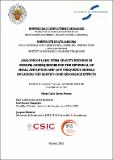Por favor, use este identificador para citar o enlazar a este item:
http://hdl.handle.net/10261/116033COMPARTIR / EXPORTAR:
 SHARE
BASE SHARE
BASE
|
|
| Visualizar otros formatos: MARC | Dublin Core | RDF | ORE | MODS | METS | DIDL | DATACITE | |

| Título: | Analysis of long-term gravity records in Europe. Consequences for the retrieval of small amplitude and low frequency signals including the Earth's core resonance effects |
Autor: | Calvo García-Maroto, Marta | Director: | Arnoso, José CSIC ORCID; Hinderer, Jacques | Palabras clave: | Spring gravimeters Absolute gravimeters Superconducting gravimeters Earth's tides Tidal potential of degree 3 Long-period tides Time stability Instrumental drift Calibration Rotational normal modes |
Fecha de publicación: | abr-2015 | Editor: | Universidad Complutense de Madrid Université de Strasbourg |
Citación: | Analysis of long-term gravity records in Europe. Consequences for the retrieval of small amplitude and low frequency signals including the Earth's core resonance effects. 253 p. (2015) | Resumen: | Temporal gravity variation measurements have been a long historical tradition in Central Europe, with some stations recording for decades. From the 80s, time varying gravity is permanently recorded at the Earth’s surface by a worldwide network of superconducting relative gravimeters within the Global Geodynamics Project of the International Association of Geodesy. In one of these stations, located in Strasbourg since the 1970s, the three main gravimeter types (relative spring gravimeter, relative superconducting gravimeter, and absolute gravimeter) have been set up. We use all these series to review the instrumental betterments. Studying the different improvements on gravimeters in the last years, mainly in terms of long term stability and instrumental drift, we show that the superconducting gravimeters can uniquely contribute to the study of the low frequency Earth's tides and small amplitudes waves. Also, the stability of the scale factor of the superconducting gravimeters is studied with the help of numerous calibration experiments carried out by collocated absolute measurements at Strasbourg Observatory. Finally, after estimating the values of the Free Core Nutation parameters, we search for the rotational normal mode called Free Inner Core Nutation (FICN), the gravity effect of which has never been observed before. For this purpose we develop a methodology to constrain the possible frequency range, through the detailed tidal analysis in the diurnal frequency band, using the 27-year superconducting gravity series recorded at J9 observatory, to separate small amplitude waves that have never been studied before, and which could be close enough to the frequency range of the FICN to be affected in terms of resonant amplitude. This work contributes to show the importance of not only the length, but also the quality of the data series to improve our knowledge of the Earth’s dynamics. | Descripción: | Tesis defendida el 24 de Abril de 2015 en la Universidad Complutense de Madrid. | URI: | http://hdl.handle.net/10261/116033 |
| Aparece en las colecciones: | (IGEO) Tesis |
Ficheros en este ítem:
| Fichero | Descripción | Tamaño | Formato | |
|---|---|---|---|---|
| Tesis_MCalvo_UCM-UdS_2015.pdf | 8,14 MB | Adobe PDF |  Visualizar/Abrir |
CORE Recommender
Page view(s)
324
checked on 05-may-2024
Download(s)
581
checked on 05-may-2024
Google ScholarTM
Check
NOTA: Los ítems de Digital.CSIC están protegidos por copyright, con todos los derechos reservados, a menos que se indique lo contrario.
